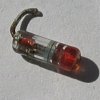Gregory
Member
I have a glass diod I think it may be a sigenel diod but it has color bans around the length of the component'
The bands are black;gray;black;red when I test it with analog multi meter it tests like a diod but I do not undrstand how to read the colour's
Do you use the resistor colour coads to determan the value If so what is the value as on a normal diod there is a band on one end,Do you take this band as part of the rading,
Can the value of the component be determend by a digital or analog meter.
The bands are black;gray;black;red when I test it with analog multi meter it tests like a diod but I do not undrstand how to read the colour's
Do you use the resistor colour coads to determan the value If so what is the value as on a normal diod there is a band on one end,Do you take this band as part of the rading,
Can the value of the component be determend by a digital or analog meter.
Last edited:





